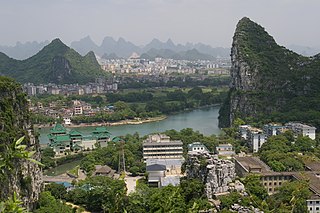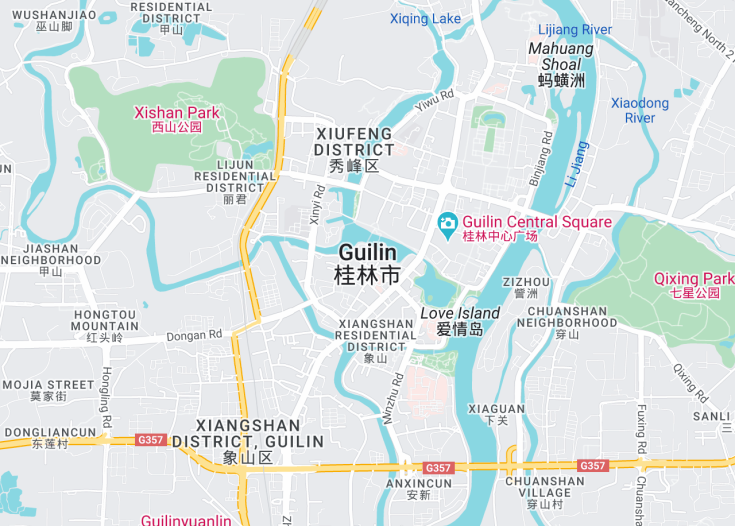Guilin, located in the northeast of China’s Guangxi Zhuang Autonomous Region, is renowned for its enchanting karst landscapes which have been immortalized in Chinese poetry and painting. This picturesque city is bordered by the Li River, famed for its crystal-clear waters and the dramatic mountains that line its banks. Guilin’s scenery is often described as being the finest under heaven. It’s a top choice for both domestic and international tourists seeking tranquility and a deep dive into an almost mystical natural environment. Highlights include not only the scenic views but also rich cultural heritage sites like the Reed Flute Cave and Elephant Trunk Hill.
Before traveling to Guilin, remember to pack comfortable walking shoes and a camera with a good zoom, as the landscapes are vast and often require some hiking to fully appreciate.
Try to visit Guilin during the late spring or early autumn to avoid the heavy tourist crowds and experience more pleasant weather, perfect for outdoor activities and river cruises.
Top things to do & see in Guilin
Select the following sights and activities to discover best tickets and tours available in Guilin.
Guilin: A Jewel of China’s Landscape
| Country | China |
| Time in Guilin | GMT+8 |
| Language spoken | Mandarin |
| Population | 4.75 million (World Population Review) |
| Currency | Chinese Yuan (¥) (CNY) |
| Airports |
|
Guilin, located in the northeastern part of China’s Guangxi Zhuang Autonomous Region, is a picturesque city that has drawn poets and artists for generations. Known for its stunning karst landscapes, Guilin’s peaks rise dramatically from the earth, creating scenery that is both surreal and breathtaking. The Li River meanders through these formations, providing spectacular views and a serene environment for river cruises.
The city’s natural beauty is complemented by rich cultural traditions. As a result of its scenic backgrounds, Guilin has developed a thriving tourism industry that delights visitors with both its landscapes and its deep-rooted historical and cultural sites. Among Guilin’s most famous attractions is the Reed Flute Cave, known for its extraordinary stalactites, stalagmites, and stone pillars formed over millions of years. Another must-visit landmark is Elephant Trunk Hill, a natural structure that remarkably resembles an elephant sipping water from the Li River.
Aside from its natural endowments, Guilin enjoys a vibrant local life that visitors often find enriching. Its bustling city markets, traditional cuisine, and friendly locals offer an immersive experience into everyday life in China while guiding you through its ancestral craftsmanship and folklore.
Historically, Guilin was considered a strategic military base and a prosperous cultural site as early as the Qin Dynasty. This historical depth adds layers to visitors’ experiences as they tour ancient villages and historic temples around the city and its environs.
Overall, Guilin represents a harmonious blend of natural splendor and cultural depth, making it an essential stop for anyone exploring China. Its landscapes inspire awe, and its cultural heritage invokes a deeper understanding of China’s vast historical narrative and aesthetic principles. Guilin is not just a site to visit, but a place to be experienced.
Where is Guilin?
Guilin is nestled in the Guangxi Autonomous Region of China, surrounded by lush green hills and the serene Li River.
| Route | Distance by car | Time by car |
|---|---|---|
| Beijing to Guilin | 1,395 miles | Approx. 22 hours |
| Shanghai to Guilin | 1,068 miles | Approx. 17 hours |
What is Guilin famous for?
Guilin is renowned for its dramatic karst mountains and the picturesque Li River which flows among them, making it a top landscape scenery destination in China.
History
Prehistoric to Han Dynasty (Before 214 BC)
Guilin’s history is as intriguing as its landscapes. The area around Guilin has been inhabited since prehistoric times, as evidenced by the Zengpiyan cave relics that suggest a settlement dating back more than 10,000 years. The discovery of ancient tools and pottery, along with various jade items, indicates that early residents were engaged in primary forms of agriculture and hunting. Guilin’s name is derived from the fragrance of the sweet-scented osmanthus trees that abound in the region.
Qin to Ming Dynasty (214 BC – 1644 AD)
The establishment of Guilin as a city can be traced back to the Qin Dynasty around 214 BC, when the first Emperor of China, Qin Shi Huang, ordered the construction of a canal to connect the Yangtze and Pearl river systems. This significantly enhanced trade and military movements in the region. During the Tang and Song dynasties, Guilin flourished culturally, becoming a hub for poets, artists, and scholars attracted by its stunning natural beauty. The city also serves as an important political and military base due to its strategic location.
Qing Dynasty to Modern Era (1644 – present)
Throughout the Qing Dynasty, Guilin continued to be a pivotal military outpost. It underwent many changes during the 20th century, especially during the Sino-Japanese War and the Chinese Civil War, where its geographic location once again proved to be of strategic importance. Post-1949, under the People’s Republic of China, Guilin has transformed into a prominent tourist destination, famous worldwide for its unique karst scenery and river views that attract millions of tourists annually. The area’s history and culture are now integral to its charm and appeal as a must-visit location.
Visit Guilin
What to see and do in Guilin, China
Guilded by its rich history and spectacular natural surroundings, Guilin offers an array of activities and sights.
- Explore Reed Flute Cave, a natural limestone cave with multicolored lighting.
- Discover the ancient art of cormorant fishing on the Li River.
- Take a cruise down the Li River from Guilin to Yangshuo to witness stunning karst landscapes.
- Visit Elephant Trunk Hill, an iconic natural landmark that resembles an elephant dipping its trunk into the river.
- Wander through the Sun and Moon Twin Pagodas, perfectly reflecting in the serene waters of Fir Lake.
Celebatory Days in Guilin
Gilin’s calendar is dotted with vibrant cultural festivals. The two prominent events include the Chinese New Year celebrated throughout late January or early February, and the Mid-Autumn Festival held around September. Both festivals offer visitors insights into rich traditions, complete with fireworks, colorful decorations, and the sharing of festive foods like mooncakes.
Best time to visit Guilin
The best months to visit Guilin are April to October when the weather is warm and conducive for outdoor activities. During these months, the landscape of Guilin comes alive with lush, vibrant scenery, making excursions along the Li River particularly breathtaking.
is Guilin worth visiting?
Guilin, with its enchanting river views and ethereal landscapes, offers a truly unique travel experience. The city’s appeal lies not just in its natural beauty but also in its rich cultural tapestry and historical sites. However, its popularity can lead to crowded peaks in tourist seasons, which might detract from the tranquility many visitors seek. Additionally, weather conditions, particularly in the rainy season, can impact travel plans. Nevertheless, the visual splendor and cultural experiences on offer make Guilin a worthwhile destination for those who appreciate nature intertwined with history.
What are the top attractions to visit in Guilin?
- Li River: Famous for its breathtaking scenery, a cruise along the Li River from Guilin to Yangshuo reveals hill formations, tranquil fishing scenes, and lush riverbanks.
- Reed Flute Cave: A natural limestone cave illuminated by multicolored lighting, displaying a magical array of stalactites and stalagmites.
- Elephant Trunk Hill: Shaped like an elephant dipping its trunk into the river, this hill is one of Guilin’s most distinctive landmarks.
- Seven Star Park: Housing seven peaks and several attractions including caves, gardens, and a zoo, this large park offers a perfect blend of natural scenery and entertainment.
These sites capture the essence of Guilin’s natural beauty and are a must-visit for first-time travelers.
What outdoor activities can be enjoyed in Guilin?
- River Cruising on the Li River: This is a quintessential Guilin experience that offers stunning landscapes of limestone karsts, rural life, and tranquil waters.
- Cycling in Yangshuo: Cycling through the Yangshuo countryside provides an excellent way to enjoy the rural scenery. Scenic routes often include Moon Hill and the Yulong River area.
- Hiking on Longji Rice Terraces: Located outside Guilin, the Longji terraced rice fields offer fantastic hiking opportunities with spectacular views over the terraces that change seasons.
- Bamboo Rafting on the Yulong River: For a more peaceful and scenic experience, bamboo rafting offers a slower pace and closer view of the water and landscapes.
These activities highlight Guilin’s allure as a destination for nature lovers and adventurers alike.
What are the best day trips from Guilin?
- Yangshuo: Just an hour away, spend a day exploring quaint villages, climbing karst peaks, and bicycling or rafting along the Yulong River.
- Longji Rice Terraces: Approximately a 2-hour drive from Guilin, these terraces offer gorgeous scenic hikes and insights into local ethnic minority cultures.
- Xingping Ancient Town: This town, located near Yangshuo, is known for its well-preserved Ming and Qing dynasty architecture and its close proximity to the best scenic bends of the Li River.
These trips provide diverse experiences from cultural explorations to nature and adventure pursuits.
Where can I try authentic Guilin cuisine?
- Local Restaurants: Dine at popular local spots like Chunji Roasted Goose Restaurant, which is famed for its Guilin-style roasted goose.
- Night Markets: Guilin’s night markets offer an assortment of local street food, including Guilin rice noodles (mifen), known for their rich and spicy broth.
- Specialty Shops: Visit traditional eateries that specialize in regional delicacies such as Lipu Taro Looped Meat or beer fish – a must-try dish in Yangshuo.
Sampling the local cuisine is essential to experiencing the cultural heritage of Guilin.
What are the unique shopping experiences in Guilin?
- Guilin Zhengyang Pedestrian Street: This bustling street features numerous shops selling everything from local snacks to crafts. Don’t miss the handmade silk products and traditional Chinese paintings.
- West Street in Yangshuo: Known for its vibrant atmosphere, West Street is packed with stalls and boutiques offering local souvenirs such as scroll paintings, calligraphy brushes, and uniquely designed clothing.
- Farmers’ Markets: Local farmers’ markets provide insight into the daily lives of the Guilin people and an opportunity to purchase fresh, local produce and handicrafts.
These shopping venues offer a glimpse into the local culture and lifestyle in Guilin.
What are the cultural highlights to explore in Guilin?
- Impression Liu Sanjie: A spectacular outdoor light show created by Zhang Yimou, staged right on the Li River, which utilizes the natural surroundings to tell a local story.
- Daxu Ancient Town: One of the four ancient towns in Guilin, Daxu allows visitors to experience traditional architecture and ancient stone streets that date back to the Ming Dynasty.
- Traditional Folklore Performances: Attend a performance offering a peek into the ethnic diversity of the region, including dance, music, and traditional costumes of the Zhuang, Yao, and other ethnic groups.
These cultural experiences provide a deeper understanding of Guilin’s historical and cultural significance.
How can I get around in Guilin for sightseeing?
- Public Buses: An economical way to travel, covering major attractions across the city.
- Taxis and Ride-hailing Services: Taxis are readily available and can be a convenient option for direct travel to specific destinations or for a full day hire.
- Bicycle Rentals: Many visitors choose to rent bicycles, especially in areas like Yangshuo, which are suitable for exploring the beautiful rural landscapes at a leisurely pace.
Consider a combination of these options to optimize your travel according to your itinerary.










